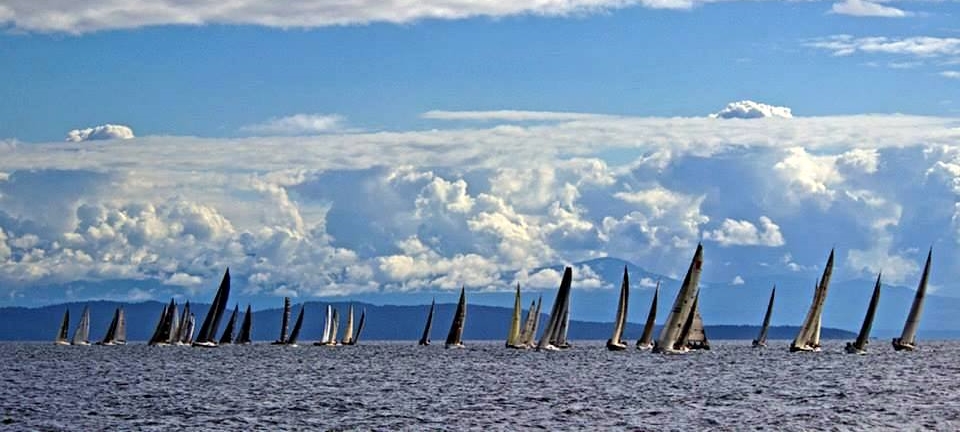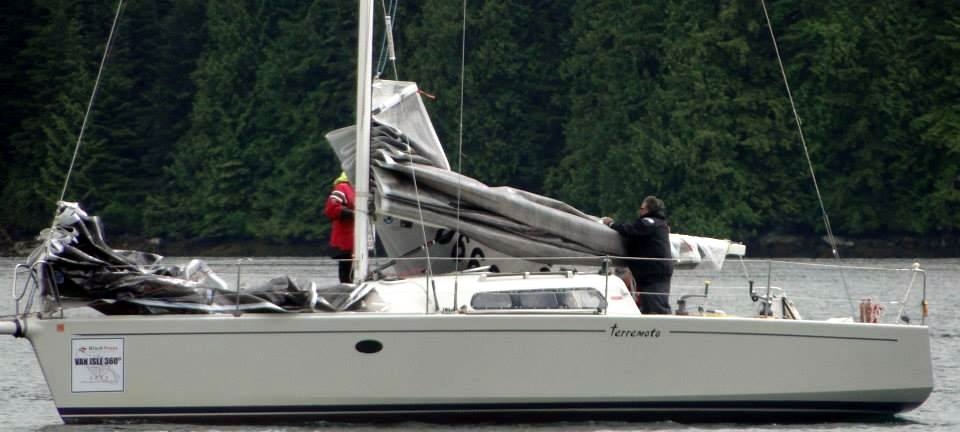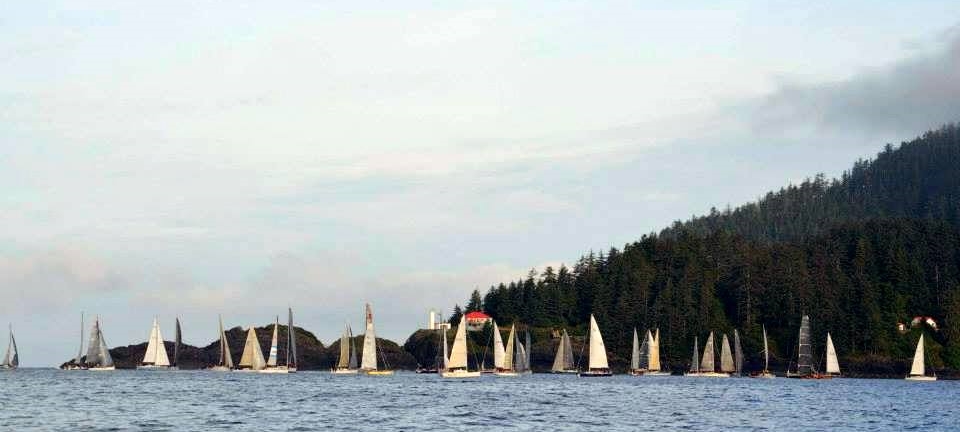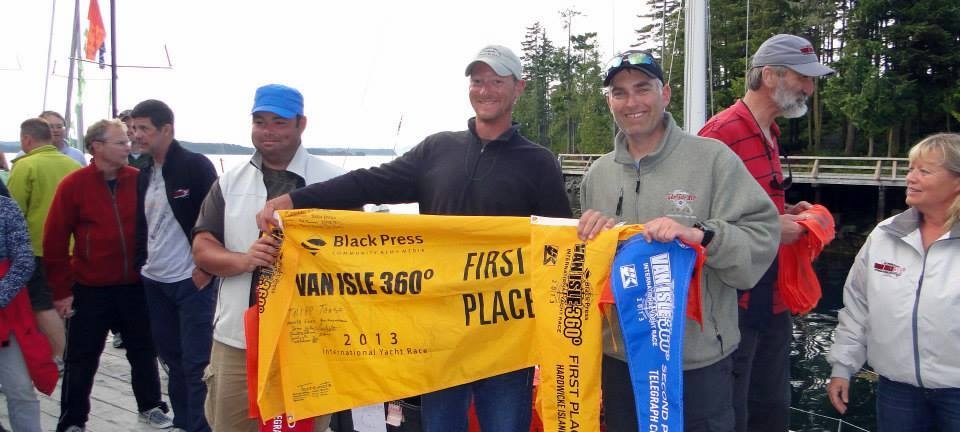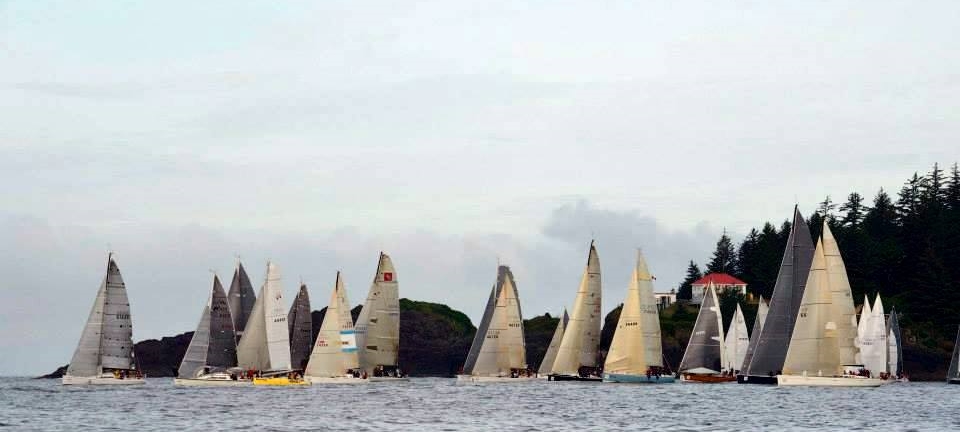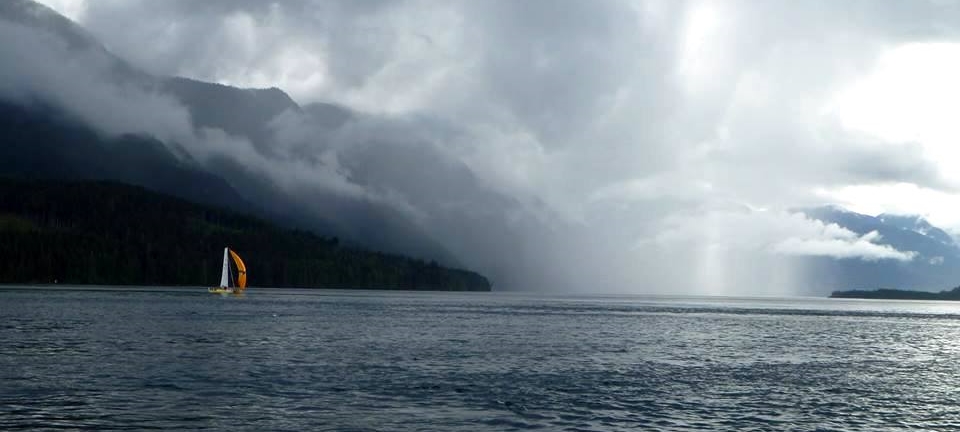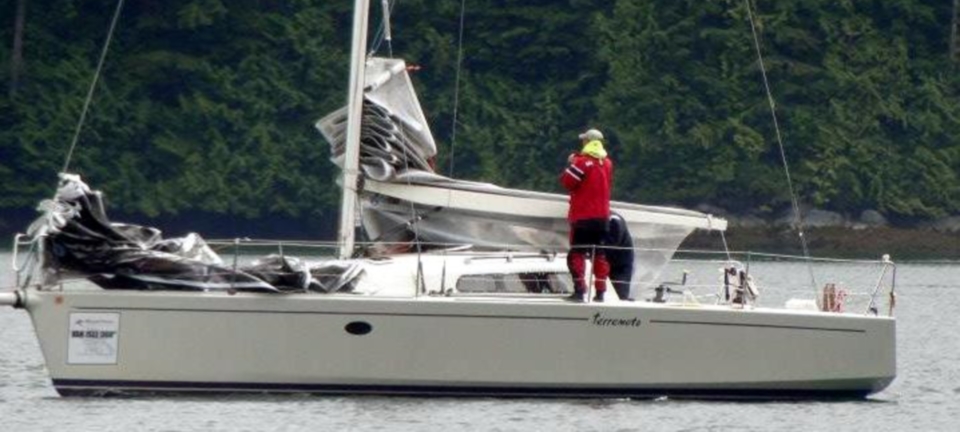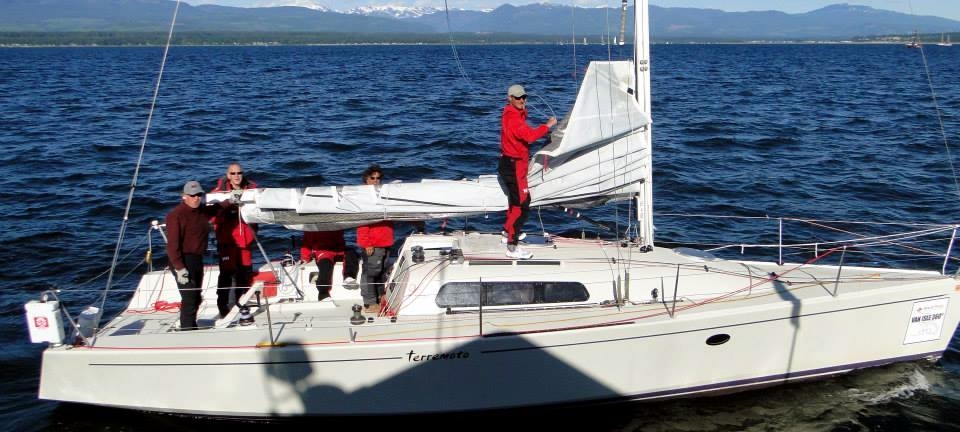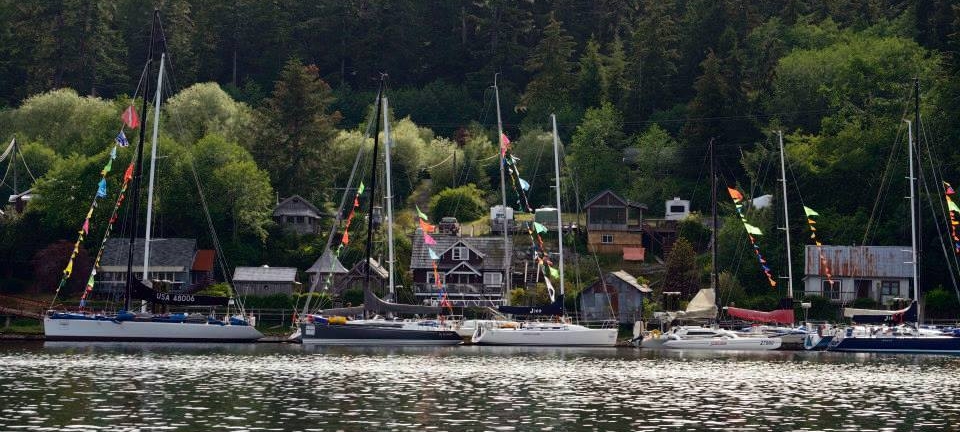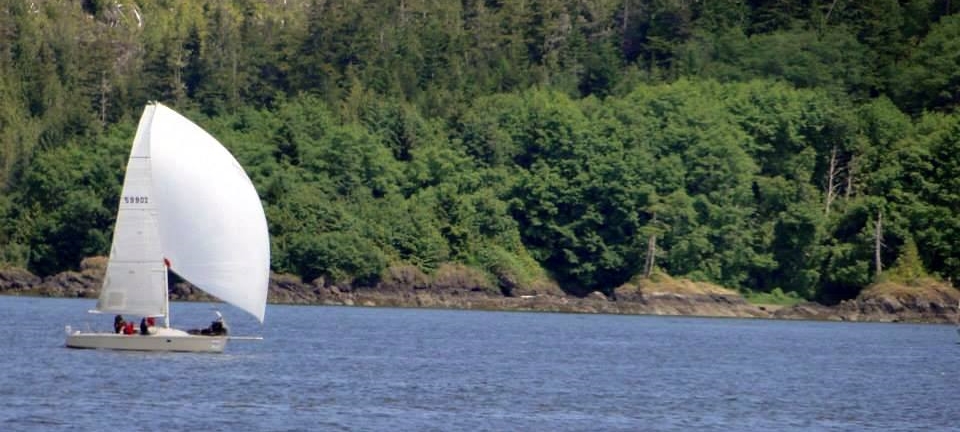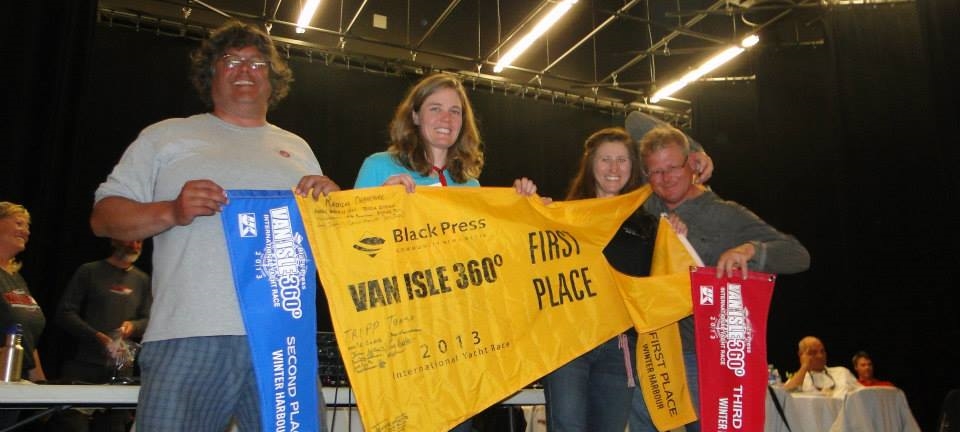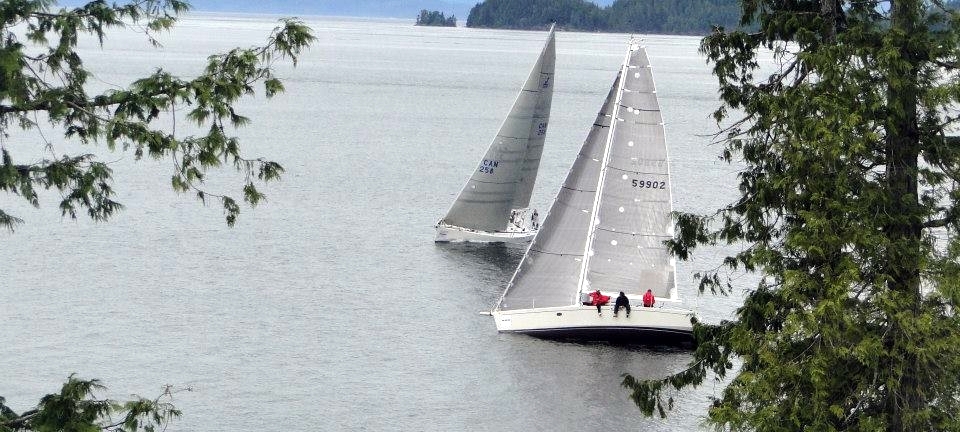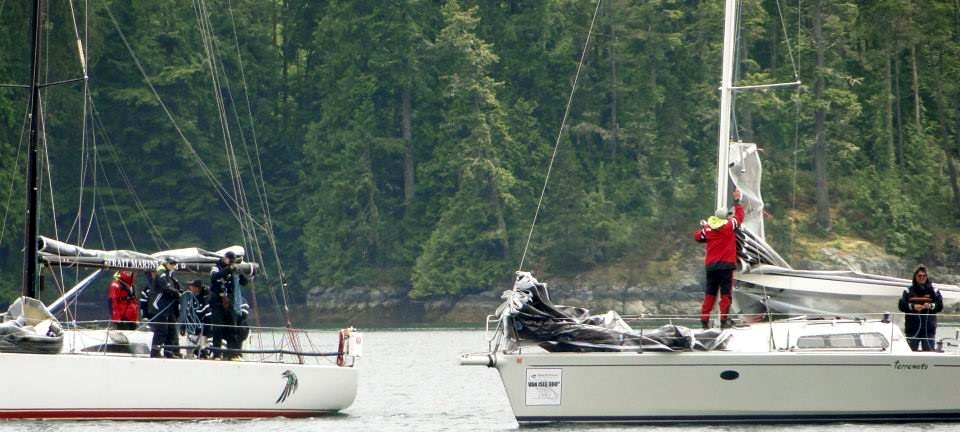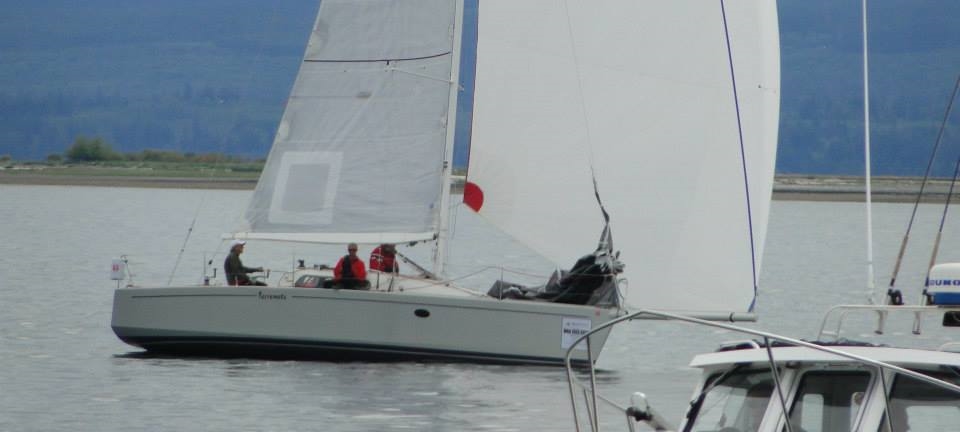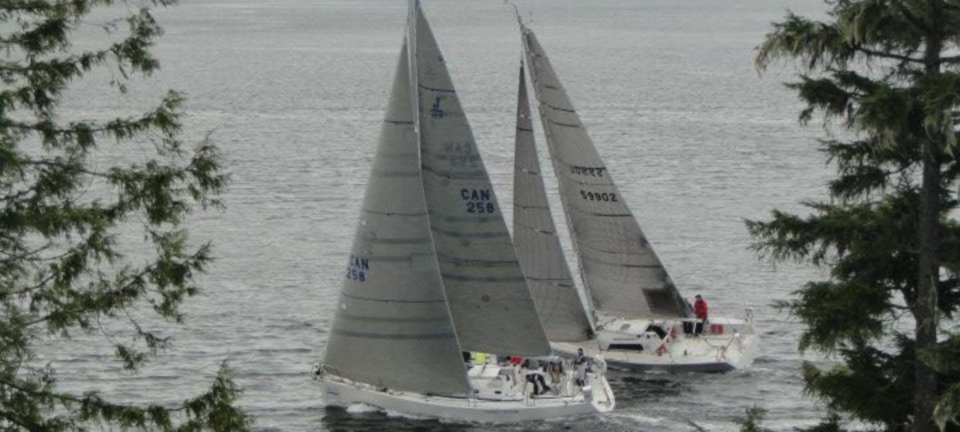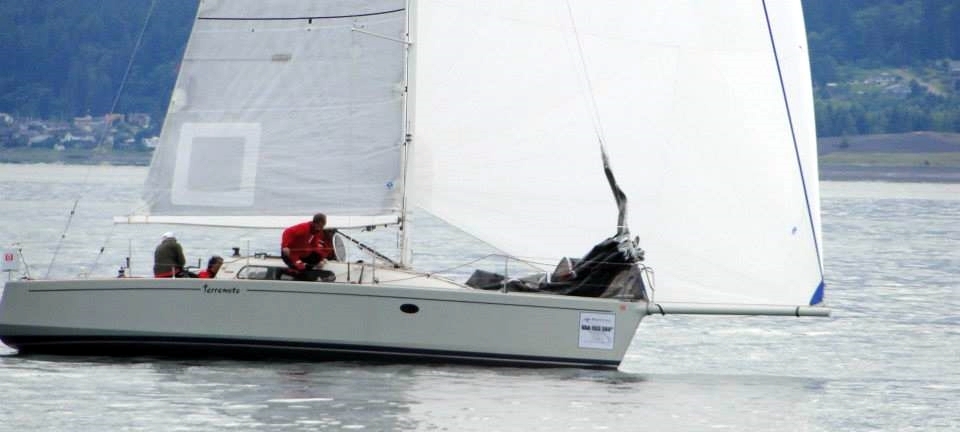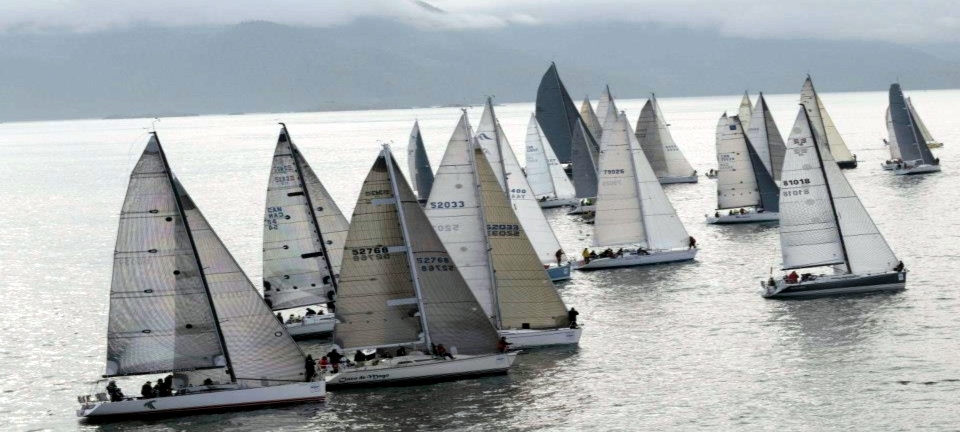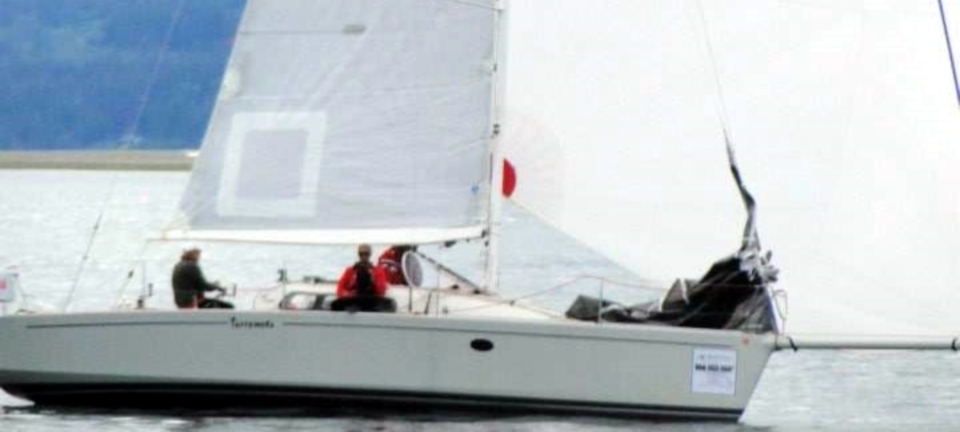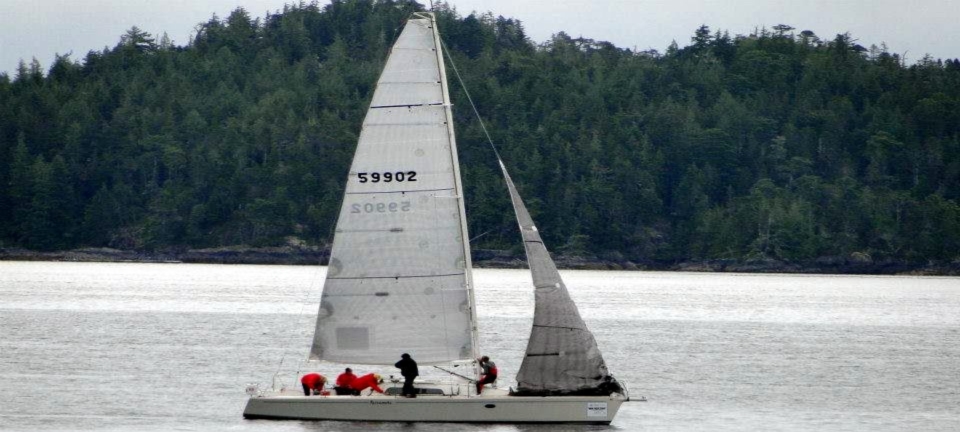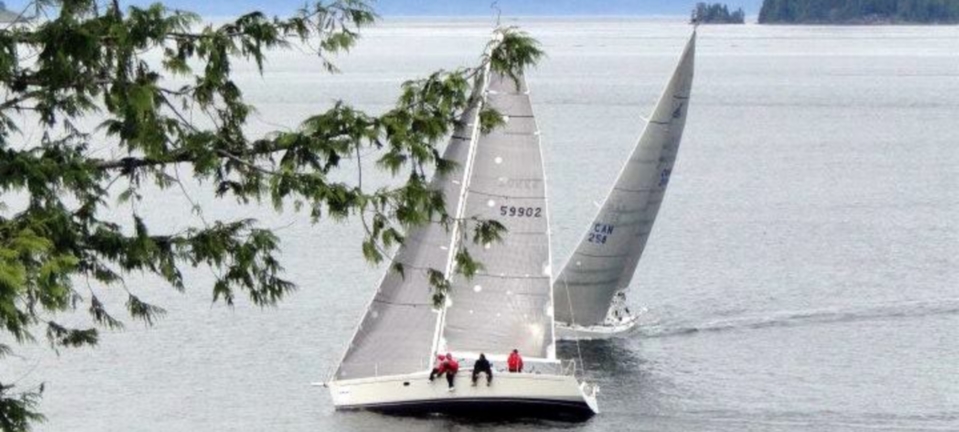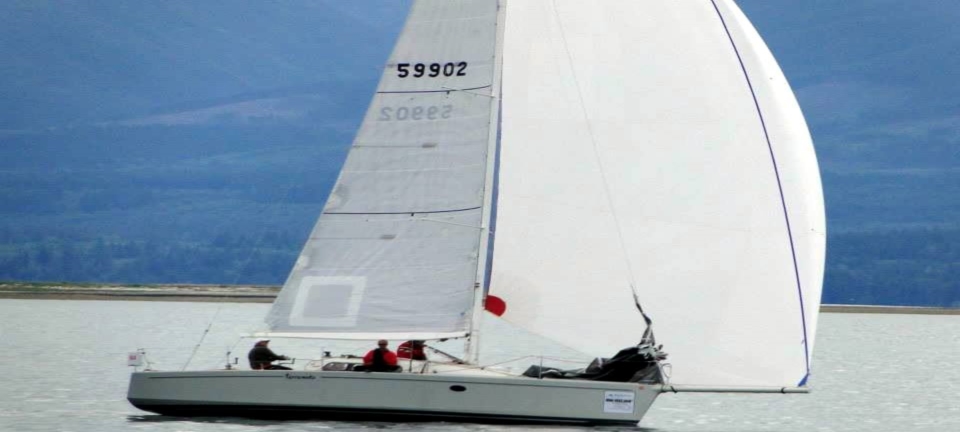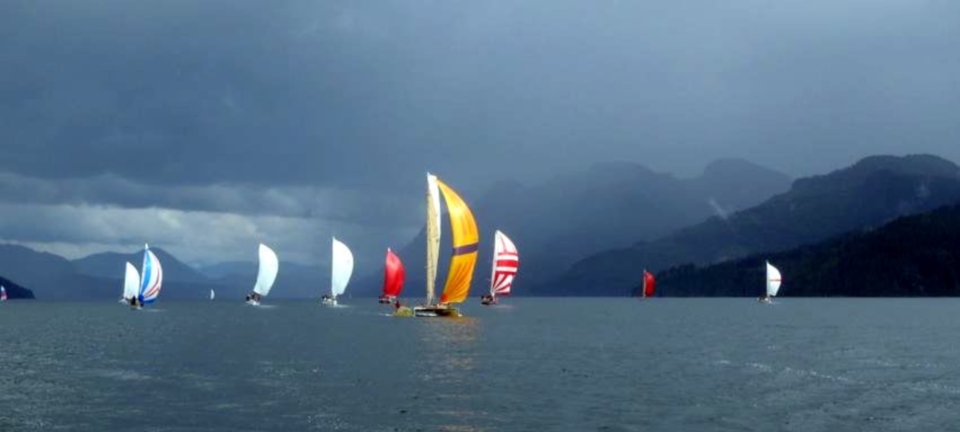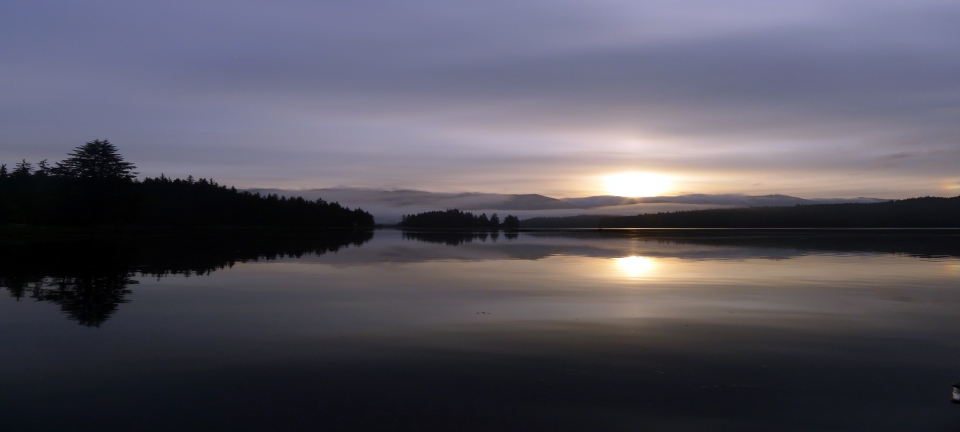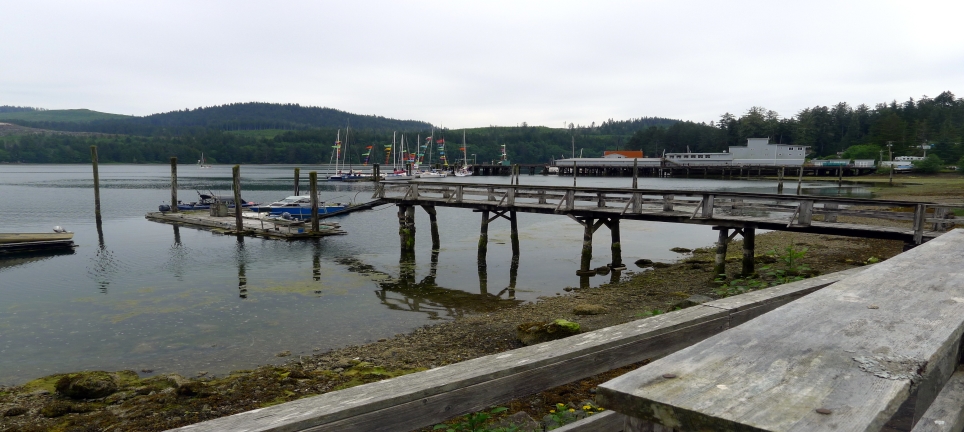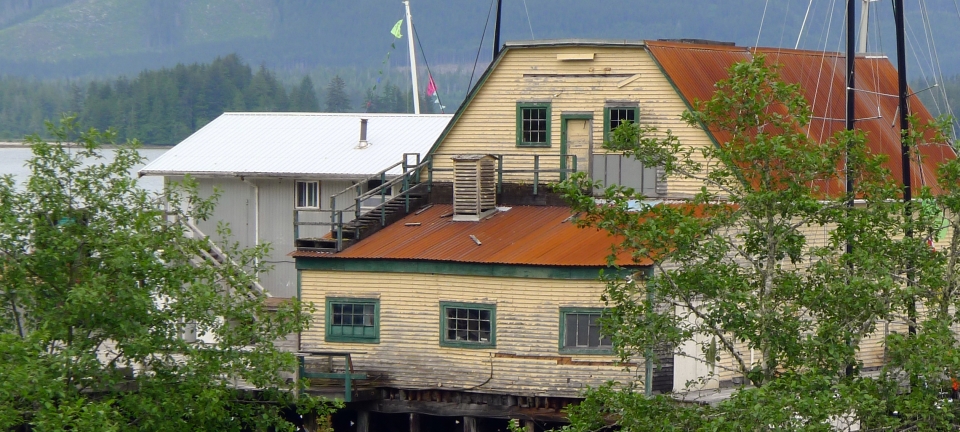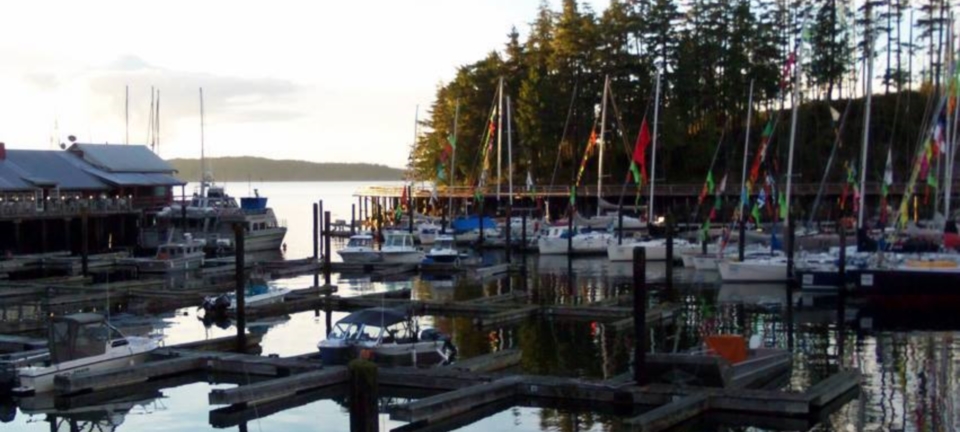In its second major ocean race Terremoto was able to overcome kelp, groundings, and a disqualification to win the two week, ten leg, 580 nautical mile Van Isle 360° Race. After winning six of the ten legs under many different sailing conditions, Terremoto was able to win its very competitive class.
Leg 1
The first day, June 8, 2013, found Terremoto’s team dressed in its new official Zhik inflammatory red team jackets. Wearing the fire engine cardinal fleece proved a continuing embarrassment for several crew members but was helpful in locating smashed teammates at late night bars and on the bow on this drizzly foggy morning in the Nanaimo, Canada inner harbor.
A now veteran team of Mark Brink, Steve Brockway, Bron Miller, Kirk Utter, and Bill Weinstein was convinced that after a year and half of racing together that all the mistakes that could be made had been made. This race would demonstrate new errors, follies, gaffs, and blunders that would stagger but not stop Terremoto.
The start began auspiciously. Mark Brink did not order Bron Miller up the mast during the start sequence. Terremoto was able to hug the pin end of the line for a good lane that allowed it to roll many of its competitors. It then tacked repeatedly as McKay Channel narrowed and the fleet rounded Gallows Point.
The fog and drizzle dissipated and a beautiful sunny day and a building breeze promised a quick race. Unfortunately the wind died. Terremoto slogged through a beat at a significant disadvantage compared to the other nine boats in its class. All of the other boats in Division 1 had longer water lines and could sail faster upwind. The race to French Creek was only 22 nautical miles so Team Moto made a decision to sail as close in-shore as it could to reduce negative current and to lessen the distance to the finish line. Weinstein also admitted that he had never seen this stunning part of the world before and wanted to explore the shoreline, play in tide pools, and build sand castles.
Terremoto was able to navigate successfully through a series of shoals called the “Brickyard Bones,” but several boats hit rocks, including what would become a formidable competitor, Raven, a 39 foot Carroll Marine 1200, ably skippered by Ian Lloyd. Terremoto sailed a very clean and efficient race and was able to finish first in its class seven minutes ahead of the second boat, Raven. White Cloud, Steve Johnson’s 39 foot Cookson 12 meter boat, finished third.
The first day’s lessons fooled Team Moto because the weather, current, kelp, “local knowledge,” and tactical and navigation decisions seemed remarkably easy. In briefly talking to the sailors of Tripp Tease, a forty foot Tripp 40-2, at the awards ceremony in French Creek, Team Terremoto learned that Tripp Tease had sailed in the Van Isle ° three times before. Its crew, led by Don Gillingham and James Volker, sailed out of the Comox Bay Sailing Club. They assured us that even though Comox was Terremoto’s next destination that ‘local knowledge’ was “overrated,” and that the course to their home was “obvious.”
Leg 2
The second day, June 9, 2013, featured a slightly longer 29 mile race from French Creek to Comox. A consistent northerly wind built in the morning to 10 knots, which generated a fair amount of wave chop. These conditions again challenged Terremoto but the boat was able to have a solid start and develop a clear lane in-shore. However, unlike Day 1, Terremoto encountered significant kelp, which slowed the boat and required continued flossing. Terremoto has a keel bulb that drew nearly nine feet, plus a long rudder and protruding propeller. These protrusions caught kelp like flypaper caught flies. Because the boat only weighs about 6,000 pounds it also sits high in the water, which means its bow doesn’t part or cut the kelp aside as much as other boats in its division.
Bron Miller became the boat’s primary “beaver flosser” and utilized a series of bizarre lines weighted by wrenches, kitchen utensils, and spare boat hardware to throw overboard and “keel haul” the boat. Because Terremoto has two windows on the bottom of the boat, one to observe the keel and one to observe the sail drive, the typical drill was for the crew of five to have one driver, one trimmer, two crew to drag the line from the bow holding the line on the port and starboard sides of the boat, and one person below to watch through the windows to direct the line to clean the kelp off the boat. Since neither window could see the rudder, Bron Miller would don a snorkel mask, hang over the stern, place his head in the swirling water and look up the boat at the rudder, sail drive, and keel. In light air this team “nautical hygiene” drill became a relatively routine task, but it became far more challenging later in the race in heavy seas on the western side of Vancouver Island.
As the day progressed, Terremoto became increasingly frustrated by its inability to generate consistent boat speed. The coastline had a number of heads and islands that created negative current back eddies. Team Moto exhausted itself clearing kelp off of the keel. While the weather was beautiful and the coastline stunning, much of the day was spent looking through windows and snorkel masks. At the north end of Denman Island, Team Moto decided unwittingly to visit Sandy Island Marine Provincial Park. The park comprises Sandy Island and the Seal Islets, and a huge forest of bull kelp. Terremoto learned later that local fisherman, conservationists, Provincial Park authorities, and even the American Pew Charitable Trust, had been engaged in bull kelp restoration around Comox. However, Terremoto sailed into it and became convinced it was Canada’s answer to the Sargasso Sea. It took 45 minutes for Terremoto to fight its way clear of the forest. In the interim, many of the local Canadian boats and American boats that had sailed the Van Isle 360° before hugged the shore and slipped between the beach and the kelp.
By the time Terremoto recovered, it was over an hour behind its class and finished ninth nearly an hour after the local team, the cunning winner Tripp Tease. White Cloud was a consistent second, and Time Bandit, a forty foot J-120 sailed by canny sailor Bob Brunius, finished third. Team Moto was dismayed but undaunted. It rationalized that it had just sailed its one throw-out and would win the more demanding third leg.
Leg 3
The third day of the race on Monday, June 10, is 28 miles from Comox to Campbell River. This leg creates the first day of truly challenging tides as the flood tidal stream entering the Strait of Georgia from the southern end of Vancouver Island meets the flood tide that flows around the northern end of Vancouver Island between Cape Lazo and Cape Mudge. The tide floods south north of Mitlenatch Island and floods north south of Mitlenatch Island. Natch means catch, grasp, or hold so the key was to track SOG (speed over ground) and COG (course over ground) to make sure Terremoto sailed with a positive current.
Terremoto lined up at the pin end of the line and had a brilliant start. Within a short time it was ahead of the fleet, at which point Mark Brink announced “we’re in trouble.” He noted that the rest of the fleet was sailing east instead of north. The day’s navigator, as well as the two members who had attended the skipper’s meeting in Nanaimo, confirmed that there had been no course correction. Terremoto decided to sail on. Nearly an hour later the first IRC boats finally passed.
IRC was adopted by the five biggest boats of the fleet because they believed their PHRF sailing handicap rating was unfair. The rest of the fleet utilized the Performance Handicap Racing Fleet (PHRF) handicaps. PHRF is a locally administered handicapping system that uses the perceived speed potential of a yacht as the basis for the handicap. By contrast, according to Freebase, a web definitional source, “technically, IRC does not stand for anything.” In the Van Isle 360 it simply meant that there was no official overall winner of the race because the five biggest boats refused to use the rating system of the other 37 boats.
The tardy appearance of the always faster IRC boats left Weinstein fuming. He then quoted from the legendary sailing nun, Miss Clavel: “Something is not right.” A scavenger hunt was conducted to find the Race Instructions. About two hours into the race Appendix B was located, which stated in pertinent part: “The start will be outside the Comox Bar between the Red Bell Buoy P54 and an orange flag on the Race Committee Boat keeping the Race Committee Boat to starboard. The two East Cardinal Buoys (PJ and PB) off Cape Lazo are marks of the course and must be left to port.” Buoys PJ and PB were now two sailing hours behind Terremoto’s stern. It became clear that Terremoto would either need to sail back to the start line and repeat the course or sail on and disqualify itself before the finish. Weinstein chose the latter course. Radical Departure, a one-design 35 footer, sailed by Andre Wojcieszek and a group of sirens, was first, followed by Time Bandit and Tripp Tease.
The team was clearly demoralized and disappointed. Like the Americans on September 18, 2013, in the America’s Cup when they were down 1 to 8, Terremoto was in danger of being mathematically eliminated after only 3 of 10 legs sailed. The team, sans Weinstein, revived itself with many rounds of fine locally brewed beer while Weinstein retired to his motel to be inspired by watching “Gilligan Island” reruns.
Leg 4
The next morning the crew emerged in the dawn to silently motor up Seymour Narrows. Seymour Narrows is one of the more beautiful and treacherous stretches of Canada’s vast western inland waterway. It is the main shipping channel for all traffic heading to and from northern Vancouver Island, the Queen Charlotte Islands, and the northwestern cost of British Columbia. Because the Seymour Narrows tighten to a little over a half mile wide, it has recorded tides of nearly 16 knots.
Seymour Narrows was described by Captain George Vancouver as "one of the vilest stretches of water in the world." 119 vessels have sunk in the Seymour Narrows. In 1958, after twenty-seven months of tunneling and engineering work, Ripple Rock, a huge rock structure just nine feet below the surface in one of Seymour Narrows’ tightest passages, was blown up with in the largest commercial, non-nuclear blast in North America. After two days of terrible racing, Terremoto was ready for an explosive race day.
Team Moto rose at 4:30 a.m. on Tuesday, June 11, to stumble to the boat and motor with the other 41 boats up Seymour Passage to start at a gorgeous inlet ten miles north of Campbell River called Deepwater Bay. The course was to follow the wider portions of Seymour Passage through a windy 26 nautical mile route between several islands to Hardwicke Island. Weinstein gripped the helm and refused to relinquish it all day. He gave a short inspirational speech to the team on how Gilligan and the Skipper had rallied its passengers. When Kirk Utter noted that the Minnow had been shipwrecked, Weinstein challenged the crew with the inspirational question: “What would Mary Ann do or what would you do to Mary Ann?” The team, acting as a Greek chorus, intoned the race instructions, and then poured over the current charts and nautical maps.
Terremoto was able to grab the pin end of the line and gained a quick lane away from the disturbed air of the fleet. It quickly shot into the lead, but the wind died. The fleet slowly inched up the channel, and Team Moto searched the steep forested slopes and snowcapped peaks shrouded in grey mists for signs of where the next wind puff would drop on the water. Terremoto tried to hold a spinnaker but was reduced to flying a wind seeker.
Terremoto was still leading the fleet as it headed to the west in Johnstone Strait around the very picturesque Chatham Lighthouse near Rock Bay. The sun came out, the wind began to build from the east, and Terremoto was able to set its spinnaker and keep up with the IRC boats. Terremoto chose to hug the Vancouver Island shore then decided to cross to the shores of East Thurlow and West Thurlow Islands. Squalls blew in, followed by glistening holes on the water devoid of wind. Terremoto dropped its kite and patiently beat up the course. Winds were so localized that Team Moto raised and then lowered its chute several times and made several sail changes. At one point Team Moto hoisted Bron Miller up the mast to see if he could see where there was any wind in the Strait. By mid-afternoon a breeze and rain began to build and Terremoto went in to an agonizing set of short tacks as it worked its way along the shore in increasingly negative current. Part of Terremoto’s division hugged the shore on Vancouver Island while Terremoto ‘kissed’ West Thurlow Island to avoid negative current. Fortunately the channel was very steep and deep so the boat could at times sail within ten feet of the rocky shoreline. Kirk Utter’s handheld GPS was relied upon to judge depth. At the end of the leg Terremoto had to sweep Douglas fir needles off the boat deck from where the mast spars had brushed up against overhanging trees.
Only eight boats out of 42 finished the race: four big IRC boats, Flash, Dark Star, Westerly, and Icon, and the four Division 1 boats, Terremoto, Radical Departure, White Cloud, and Raven. All four Division 1 boats finished in a tacking duel in the middle of a storm cell separated by barely two minutes.
The other six Division 1 boats and all 34 other boats failed to finish. Dilligaf, a thirty foot Ross 930 owned by Keith Climenhaga, described the fleet’s predicament as follows: “the entire Div 2 and 3 ended up stacked up on the beach short tacking en mass (with some interesting close quarters situations) looking for current relief. But as we got closer the currents became whirlpools and the final point impenetrable. And we were up front with big race boats like New Haven behind us. WOW. Then chaos broke out as no one could punch through and it became a 20+ boat game of bumper boats as some tried to anchor, others got set downstream, others spun in tide pools. Boats came together as crews rushed around with bumpers and hands and fended off as they crashed into each other. As a light boat we were doing reasonably well and tried to ride the edges of the whirlpools, but then some large heavy boat would swirl around in the current and come in and we would rush to the rail and the crews would push off each other. We’d then get spun away from the force and have to retry our a little gains. Generally we saw a lot of good boatmanship and everyone was laughing and making jokes about the close contacts. There were some worse incidents and fortunately no major carnage or injuries. Dragonfly for example almost made the corner then got sucked out into the centre channel and got sucked back several miles!”
Team Moto was exhausted by the challenging conditions and the many sail changes, tacks, and tactical decisions. It was gratified by the outcome, particularly as it became apparent that so many of the other boats could not finish in the allotted time. It was also euphoric as the setting off rocky Eden Point in Chancellor Channel was sublime with a beautiful nautical crossroad surrounded by driftwood beaches, gorgeous, jagged snowcapped peaks, and mooring at a floating salmon farm with 600,000 jumping, swirling salmon.
A very fresh salmon dinner was provided by the British Columbia Salmon Farmers Association and Marine Harvest Canada for nearly 400 sailors. The food, hospitality, and venue were outstanding and the tour of the Hardwicke Island Salmon Farm provided a valuable insight on marine aquaculture and its importance to the British Columbia economy. Fortunately, the crew was able to muzzle Weinstein before he committed social malpractice by making an inflammatory red comment about salmon farming.
Instead of spending the evening moored with the fleet, Terremoto motored over to Sayward, a small logging village located on Vancouver Island. There Terremoto was greeted by its wonderful “shore support unit,” Sarah Brink. Sarah did a fantastic job during the two week race procuring and storing food and gear, and transporting Team Moto to and from night lodgings, restaurants, psychoanalysts, and bars. She always was positive, supportive, and sympathetic, and even reluctantly wore the controversial rouge jacket.
Leg 5
The next morning, Wednesday, June 12, 2013, Team Moto awoke early again so that Terremoto could motor back to the start line. The sailing legs were getting progressively longer and harder, and the fleet needed to sail over forty nautical miles to Telegraph Cove on Vancouver Island. The start again began off Eden Point in dark clouds and light winds and rain. However, as the fleet continued to move down the geographical marvel of Johnstone Strait the beauty of the surroundings continued to astound everyone.
Johnstone Strait is a 68 mile channel along the north east coast of British Columbia. Opposite the Vancouver Island coast, running north to south, are Hanson Island, West Cracroft Island, the mainland British Columbia Coast, Hardwicke Island, West Thurlow Island and East Thurlow Island. Johnstone Strait is between 1.6 miles and 3.1 miles wide. The Strait was named by James Vancouver for James Johnstone, master of the armed tender Chatham. In 1792, his survey party established that Vancouver Island was an island. Johnstone Strait is home to approximately 150 orca whales, a few of which Terremoto spotted that day.
The wind was again light and resembled the prior day’s racing conditions. Terremoto again had a good start, but then promptly sailed in to a hole and watched as virtually the entire fleet sailed passed. Mark Brink played a decisive role in figuring the right way to go, but every Team Moto member had ‘eyes out of the boat’ searching for clues on wind and current conditions. Fortunately, Terremoto was able to put up its spinnaker and miraculously was able to sail through the entire fleet. It was beautiful to look down the channel and see 42 spinnakers flying in many colors like a quilt on a blue background.
There were again multiple sailing changes and very challenging tactical decisions. Terremoto was able to reach the front of the fleet and then managed to run down the entire fleet of big boats. Flash, a One Design 48 footer sailed by the outstanding Steve Travis, finished first in a time of 7 hours 33 minutes, followed by the other four big boats within 24 minutes. Terremoto finished only 16 minutes behind Flash and beat New Haven, a Ker 46 skippered by John Kerrigan, across the finish line. New Haven won its class that day on a corrected time basis. Tripp Tease finished 10 minutes behind Terremoto, but on a corrected time basis came in only nine seconds behind! Papillon, an Aerodyne 38 sailed by Patrick Frisch, came in third. It was an amazing roller coaster day of emotions and sailing.
Telegraph Cove was one of the two really charming and unique towns Terremoto visited on Vancouver Island. Nestled in a cove between the Georgia Strait and a rain forest, Telegraph Cove is a beautifully restored rustic lumber and fishing town whose old moss covered cedar shake buildings hug the shoreline on wooden stilts and boardwalks. Telegraph Cove (population around 20) seems to have been frozen in time. While a more modern resort has blunted its postcard panorama, the town has morphed into an eco-wonderland of whale watching, kayaking, and fishing. It was the perfect location for the fleet to tie up half-way through the race. Bron Miller accepted the victory pennant and after a nice salmon dinner and beer Sarah Brink drove Team Moto to its private B & B nestled in its own cove north of the Telegraph Cove.
Leg 6
Leg 6 from Telegraph Cove to Point Hardy was only 28 miles, but unlike earlier races the fleet was leaving the protection of Johnstone Strait and entering the more open and exposed water of Queen Charlotte Strait. The race quickly reverted to a more conventional race. The big boats led by Icon, Flash, and the Santa Cruz 70, Westerley, crewed in part by the University of Victoria Sailing Team, tacked miles out into the Queen Charlotte Strait in search of wind. By contrast Johnathan McKee’s Dark Star and Terremoto hugged the Vancouver Shore. The thought was to sail the closest distance to the mark, coupled with playing local currents through Pearse, Cormorant, and Malcolm Islands.
Both Dark Star and Terremoto are Paul Bieker designed water ballast boats. Rapid wind oscillations forced Terremoto and Dark Star to load and unload their water ballast frequently. The day was full of further distractions as White Cloud exchanged leads with Terremoto at least ten times during the day.
Notwithstanding two prior winning days, Terremoto still had two very bad results, so the pressure to win was palpable. There was considerable criticism as to why Terremoto was sailing so close in shore, particularly when it was again being forced to “beaver floss” for kelp. Compelling discipline and reasoning won out. Terremoto could not win against any of the boats in its class in a straight beating ‘drag race.’ It had to use the currents and minimize the distances it covered to compensate for its small 35 foot hull length.
The scenery was striking, but unlike the vertical islands of the Johnstone Strait, the serene sand beaches on Vancouver Island and the glistening glaciers of the high mountains of the mainland’s Coast Range provided spectacular vistas. Terremoto and Dark Star came into view of Port Hardy when from the east appeared the rest of the big boats, along with White Cloud. While Terremoto and Dark Star furiously tacked along the coast the other boats came roaring in to Port Hardy harbor. Icon finished only 39 minutes in front of White Cloud. Terremoto had a grim six minutes as Mark Brink berated Weinstein for allowing White Cloud to get in front because of sloppy sailing. Fortunately the wind filled in and Terremoto squeezed out a victory on a corrected basis by three minutes. Tripp Tease and Admiral Denny Vaughn’s 40.7 foot Beneteau, Bravo Zulu, were third and fourth just a few minutes behind Terremoto.
Terremoto felt vindicated that it had won the last three legs. Team Moto recognized, however, that if it couldn’t fly its spinnaker in the coming distance races that several other boats in its class could easily win the remaining legs and win the race. Team Moto piled in to the white crew truck piloted by Sarah Brink and headed for a well-deserved dinner.
Leg 7
The seventh leg was a long 63.4 nautical miles around the north end of Vancouver Island. It was the first offshore element with the fleet sailing around the north end of Vancouver Island at Cape Scott out in to the open Pacific Ocean. A particular concern was the Nahwhitti Bar at the entrance to the Goletas Channel. During a flood tide, currents sweep around the top end of Vancouver Island and down the straits and inlets for about six hours. A portion of that water is squeezed between Hope Island and the Vancouver Island shore. During a large tide, currents can reach five or six knots. Shallow depth also plays a significant factor. Strong summer northwesterly winds can create huge breakers.
Fortunately, Angus Brackett, a fine sailor who had been sailing with Bravo Zulu, agreed to join Terremoto for three legs of the race. He brought with him relatively mild weather. Terremoto had a terrible start and managed to run aground. Fortunately it was able to recover quickly to catch the rest of the fleet in light air. The entire fleet entered Goletes Channel instead of taking the longer outside route into Queen Charlotte Strait. The day proved sunny and as the fleet entered the Goletes Channel the wind built from the east allowing Terremoto to fly its kite. Hurst and Nigei Islands quickly passed to starboard but then the wind died as Terremoto approached the Nahwhitti Bar. Terremoto decided to follow conventional wisdom by hugging Hope Island. It was rewarded by hitting a massive amount of kelp, which required several “back downs” and repeated flossing.
Finally, fed up with creeping on the shoreline and seeing a calm sea, Terremoto decided to throw caution to the wind. It sailed diagonally over the shallowest part of the bar. Other than a few larger rolling waves, Terremoto had broken a nautical taboo and was rewarded with only two boats ahead, Flash and Icon. Terremoto decided to press its luck by relying on Kirk Utter’s handheld GPS and sailed close to the remarkably wild and unspoiled northern shore of Vancouver Island. Terremoto sailed into Shushartie Bay and was able to exit even farther ahead of White Cloud and Dark Star. It then sailed between shoals as it beat west towards Cape Scott. Several boats tried to follow Terremoto but with mixed success. Westerley ran aground with an audible bang.
By the time Terremoto reached Cape Scott it had still managed to hold off all boats accept the long gone Flash and Icon and the giant 40 foot catamaran Dragon Fly, sailed by Richard Ackrill. As the sun quickly set Terremoto rounded the Cape Scott Light House and headed in increasingly heavy seas and wind south down the west coast of the rugged Vancouver Island coast. It was only a matter of time beating in the heavy waves before White Cloud and Dark Star would run down Terremoto. As the sun went down twelve hours in to the race, Terremoto went into its four hours on/four hours off shift and at 10:00 p.m. Brockway and Weinstein went below. Brackett and Brink took turns driving as Utter and Bron fought through kelp.
While Brockway and Weinstein blissfully slept, Terremoto drove in to a monster kelp forest in relatively heavy seas and a dark night. After about 45 minutes, Brackett, Miller, and Utter were able to wrestle and pull a huge ball of bull kelp up from the keel and drag it to the stern of the boat. By the time Terremoto limped passed Kains Island Quatsino Light Station at 3:35 a.m. White Cloud had already finished for 90 minutes. Team Moto was so exhausted and dispirited that when it docked at sunrise it trudged up the hill to collapse in tents Sarah Brink had pitched. Terremoto finished second in a difficult eighteen and a half hour race to a triumphant White Cloud. It was the sixth boat to finish. Radical Departure arrived an hour later to claim third place. The final boat in its division, Bravo Zulu, took over 27 hours to finish the race. It took so long for the Division 2 and 3 boats to finish (20 to 32 hours) that the fleet didn’t enjoy its award ceremony until Saturday night, June 15.
Winter Harbour is a really remote location. People are so rare that sea otters and seals were not wary and frolicked around the boat. The extra day allowed the team to rest, dry out, and make Terremoto ship shape again.
Leg 8
When the fleet lined up off the Quatsino Light House for the start on Sunday, June 16, there was a noticeable difference in the level of rest and conditioning between the big boat and Division 1 boats and the still exhausted Division 2 and 3 fleets. Ahead was the longest stretch of the race, a 138 nautical mile race off the feral and rugged west Vancouver Island coast to the village of Ucluelet. The Race Committee advised that “storm force winds are not uncommon in this area at all times of the year.” Regular radio call-in times to the Race Committee for safety were mandatory.
Terremoto had a solid start and chose once again to hug the coast rather than sail sixty to 100 miles off shore as many boats did. The theory of the larger boats was that it could always find greater wind off-shore that would add the speed to compensate for the greater distance. Sailing out in to the Pacific would also avoid the Brooks Peninsula.
The Brooks Peninsula is the third of three large navigational hazards (the other two being the Seymour Narrows and the Nahwhitti Bar) in the Van Isle 360° Race. The Brooks Peninsula juts 12 miles into the Pacific Ocean and is known for its fog, rough seas, and very high winds. The area is known as the “Graveyard of the Pacific” for the many ship wrecks that garnish the coast line.
As it approached the Brooks Peninsula the sea became calmer and Terremoto was able to sail up to the Solander Islands at the western tip of the Brooks Peninsula. Puffins and cormorants perched on rocks above hundreds of sea lions that warmed themselves in the sun. As Terremoto edged up to the shoals surrounding the islands, many sea lions slid off the rocks in to the ocean and swam under the boat.
Vancouver Island’s western coastline looks like God pressed his fingers into dough before it was baked. Huge fjords are divided by three thousand foot mountains covered in old growth forest that spill in to the Pacific Ocean. Terremoto skirted along the rugged shoals and sandy beaches.
The wind continued to lighten forcing Terremoto to sail to sea. The fleet was scattered over a several hundred mile area and Terremoto wondered if it had made the wrong decision of not sailing out in to the ocean. By evening the wind had died to less than three knots. Terremoto raised its spinnaker and sailed ‘hot’ angles to maintain a boat speed of roughly three knots. Terremoto again adopted a four hour shift and slowly sailed through the darkness down the coast.
By early morning the sea breeze picked up. A squall blew from the west and Terremoto, steered by the calm Angus Brackett, sped down the coast in several hours of 11 knot plus power reaching. The winds eventually lightened and Terremoto tried to sail a vector to the finish line. The shifting winds forced Terremoto to tack often as the wind continued to lighten. The frustration and tension was broken by several whales breaching near the boat. As Terremoto approached the Amphitrite Point Lighthouse it saw two sails in the distance. One of the crew through binoculars misidentified them as Division 1 boats. However, as Terremoto beat on it realized that both of these boats were ‘parked’ and they were the big boat New Haven and the 35 foot catamaran Bad Kitty, sailed by Bob Davis and Ron Tomas. Terremoto was able to fight its way along a beautiful sandy beach for several miles through many tacks. When Terremoto finally called in to the Race Committee to announce its pending line crossing it noted that the boat had been stuck “in a time space continuum.” Terremoto finished in 33 hours and 25 minutes. Time Bandit crossed the line only 13 minutes later on a corrected basis followed immediately by Tripp Tease.
Ucluelet is located at the northern edge of Barkley Sound, which is comprised of hundreds of beautiful small islands, including the Broken Islands Group. The harbor is an exquisite narrow channel entered through a cluster of rocky spires. The Ucluelet First Nation, the Yuu-tluth-aht people ("people of the safe landing place" or "people of the safe harbour" in Nuu-chah-nulth), named the town and area and still play an important role in modern Ucluelet today.
While Steve Brockway drove Terremoto down the channel, Weinstein regaled the crew with the area’s history. North of Ucluelet at Nootka Sound, Juan Pérez anchored and traded in 1774. In 1775 Juan Francisco de la Bodega y Quadra sailed along the coast of Vancouver Island. The famous Captain James Cook anchored in Nootka Sound and went ashore in 1778. The Nootka Sound Controversy involved the competing claims of Spain and Britain for control of fur trading and navigation in the north Pacific Ocean between 1783 and 1794.
The unwanted history lesson was disrupted by Bron Miller, who was tracking the progress of Radical Departure to the finish line. Miller described his intent to radically depart with a certain One Design 35 crew member that evening.
The crew bedded down in a comfortable B & B while the remainder of the fleet slowly arrived. The last boat took 39 and a half hours to complete the leg so Team Moto was able to spend a rest day to do laundry, see the sights, and hoist students from Ucluelet Elementary in a bosun’s chair up and down Terremoto’s mast.
Leg 9
Team Moto, refreshed and rested, had another good start in breezy conditions on Wednesday, June 19. Barkley Sound to port was beautiful and whales swam to starboard as Terremoto raced down the coast. Vancouver Island ‘bends’ to the east and the wind clocked from the northwest, which allowed Terremoto to raise its spinnaker and sail away from the fleet. Although the course to Victoria was 97 nautical miles, the morning breeze promised a quick race. With Terremoto in front of virtually the entire fleet, Mark Brink went below to take a noon siesta. Angus Brackett took the helm and Terremoto stayed along the western shore of Vancouver Island.
Terremoto noticed that the fleet, led by Flash, appeared to be sailing south to Hawaii. While Terremoto slowly inched eastward, most of the fleet continued to sail to the American shore at the tip of Cape Flattery on the Olympic Peninsula. Even more alarming, White Cloud, Raven, Radical Departure, Tripp Tease, Papillon, and Time Bandit had all caught up to Terremoto. Brink woke up and then melted down.
A salty soliloquy occurred and the crew, whose faces now matched their bright red jackets, jumped in to action. Terremoto sailed a hot angle to the American shore and took the stern of most of its division of boats. The wind continued to build from the west and Terremoto was finally able to employ its spinnaker to maximize boat speed. It quickly was able to overtake most of the other boats in the fleet again and was able to ‘sail fast and deep’ with its kite.
By the time Terremoto reached Race Rocks in the twilight the wind was roaring above 20 knots with gusts approaching 30 knots. Weinstein, tired from a long day of driving and terrified of keeping a kite up in the darkness as Terremoto negotiated the Race Rocks, surrendered the tiller to Mark Brink. Then, in the finest Team Moto effort of the race, Terremoto rocketed through Race Rocks at over 20 knots. With Brockway keeping sight of the navigational lights, Weinstein calling the puffs and spilling the traveler, Brackett flying the kite, Utter checking the depth and reading the controls, and Miller on the vang and main sheet, Brink drove like a man possessed. New Haven, which was following Terremoto through Race Rocks, said that all it could see was Terremoto’s spinnaker. Its hull was hidden by two large waves on either side of Terremoto’s hull created by a planing Terremoto.
Terremoto completed the race in just 13 hours and seven minutes, half the time that it took to complete the same distance in the Swiftsure just three weeks before. Time Bandit finished nearly an hour later but on time corrections finished second ahead of White Cloud. As Team Moto checked in to the same hotel as the Swiftsure, it noted that the contrast between the ‘Driftsure’ and this leg could not have been more dramatic.
Leg 10
The final leg from Victoria to Nanaimo is 60 nautical miles but is the most heavily weighted race because there are so many routes through the Gulf Islands to Nanaimo. These strategic course decisions can significantly lengthen or shorten the distances and if one is trapped by light winds one can be stuck in these narrow passes between the islands with significant adverse current. Sailboats also need to avoid ferries, freighters, and cruise ships.
Terremoto had mathematically eliminated all of the boats in its division except White Cloud because of its six wins and one second place. The decision by the big boats to not use a PHRF rating meant there was no competition for best overall boat in the fleet. Therefore, Terremoto chose to cover White Cloud regardless of whether it was the optimal course.
The race started on Friday, June 21 with a literal bang. A heavy current was pushing the boats on the start line towards the committee boat. After a recall, the second start was pandemonium. Terremoto was able to stay to leeward of a number of other boats who were pushed by the current towards the Committee Boat. Radical Departure hit the Committee Boat and Raven ‘t-boned’ Astral Plane, a J-109.
Terremoto avoided the ‘pile-up’ and had a good start as it headed towards San Juan Island. It sailed an unusually conservative race as it covered White Cloud and chose to not sail between Victoria and Discovery Island. There were significant wind shifts during the race and at one point the wind was on the fleet’s nose. This did not deter Flash from sailing directly up wind to pass Icon to leeward.
Most of the fleet sailed through Active Passage. However, Terremoto wanted to go up the inside of Galliano Island to Porlier Pass. White Cloud chose, however, to enter Active Passage so Terremoto tacked and covered White Cloud. The decision was fatal for the majority of the fleet as Dark Star, New Haven, Tripp Tease, Papillon, and Kiva chose to sail through Porlier Pass. Bad Kitty made an even more audacious decision to sail through False Narrows, a very shallow passage with currents above four knots between Gabriola and Mudge Islands. These boats were rewarded by finishing hours ahead of the rest of the fleet.
Terremoto spent the remainder of a gorgeous summer day beating up the Georgia Straits to Nanaimo. Terremoto stayed in the middle of the channel to cover the fleet, which tried to capture more wind by sailing by the Tsawwassan ferry terminal. By early evening, Terremoto was struggling in a very light breeze to stay ahead of a pressing White Cloud and Radical Departure. As Team Moto rounded the north end of Gabriola Island the wind died completely. Brink took the helm and once more saved Terremoto from disaster by somehow nursing two knots of speed in a two knot breeze. The breeze then filled in as night fell and Terremoto was able to regain its composure and ‘legs.’ It completed the race in third place in 14 hours and 14 minutes, three and half hours behind Papillon and Tripp Tease.
The Van Isle 360° Race was a “perfect” sailboat race because of its tremendous diversity in scenery, sailing conditions, and emotions. It demanded skill, competence, patience, and determination of a great crew, the wonderful support of Sarah Brink, and the extraordinary eccentric sailing genius of Mark Brink. The competition among the competitors, particularly among and between the IRC and Division 1 boats, was very high but dissipated quickly after every race over a beer. Jeff and Sylvia Motley and their Race Committee were superlative, and the local communities, sponsors, and First Nation participants made Team Moto feel very welcome. Terremoto was very fortunate to participate in the Van Isle 360°, its favorite sailboat race.




